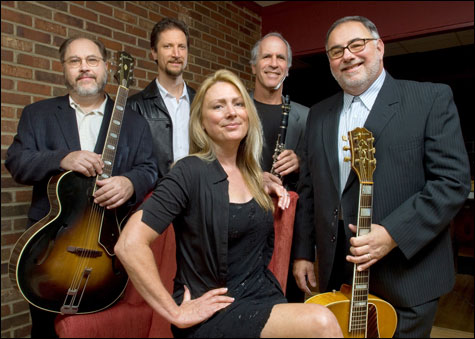
JOYFUL NOISE: Crownover (center), Robillard (right), and the boys. |
In 1991, Martin Amis wrote a book titled Time’s Arrow, in which he tells a story backward — literally, all the events happen in reverse sequence. In a way, this is what Duke Robillard is doing in music. He’s telling his own story by looking backward. Since leaving Roomful of Blues, the vintage guitar hero has moved forward by reaching back into the annals of American blues, swing, jazz, and R&B and by doing so, he’s told a pretty incredible story.
The latest chapter in that story is Sunny and Her Joy Boys, a quintet based upon the archetype of the small jazz and pop ensembles of the early ’30s. “I’ve had it in my head for 35 years, since leaving Roomful, to do something like this with swing tunes and ballads, but something always came up and it never happened.”
One night, serendipity struck. Charlie Sawyer, a Harvard professor and blues musician, invited Duke to play the prof’s closing night gig of his course in Blues History. Sawyer’s band, 2120 South Michigan Avenue, also played and they happened to feature a bewitching vocalist named Sunny Crownover. “I had never met her and when I heard her sing I was very impressed,” says Robillard. “She closed the set with a version of Etta James’s classic ‘At Last’ and she nailed it.”
From that night, Robillard and Crownover stayed in touch. When she emailed to say she’d be eager to work with him, Duke sent her a passel of possible covers they could collaborate on, and the project began to take shape. “I sent her things by Hadda Brooks, Ivie Anderson, Billie Holiday, and Helen Humes, all my favorite songs from that era.”
Crownover dug the tunes and, at last, Robillard’s long-simmering idea had begun to boil. He assembled a band, including clarinet master Billy Novick, bassist Jesse Williams, and guitarist Paul Kelisnikow. They’ll make their debut this weekend at the Blackstone River Theatre. “We called ourselves the Joy Boys because that’s what Helen Humes called any band that backed her up. Helen sang with Count Basie for a while, and Roomful did quite a lot of stuff with Count Basie back then. So Sunny thought it would be a pretty fitting name for a lot of reasons.”
Crownover, a peripatetic military daughter who spent most of her adult life in and around Austin, Texas, began singing for acoustic blues and roots bands at 14. Since moving to Boston, she has become one of the Northeast’s artists to watch. Which is exactly what Robillard did, very closely and with much fondness.
“I’ve tried to throw a project like this together for quite some time,” he says. “But I never seemed to find the right voice.” Duke has worked with some fabulous singers, but to his mind no one had the right stuff to get such a special project off the ground. “The singer here needs to have a sense of swing and timing,” he says. “It’s not a belting style of music; it’s more understated. The emotions in a song come from nuance and from subtlety, which is why so many belters have trouble with material from this period.”
Over the last several decades, Robillard has played with an impressive roster of A-list performers, including Bob Dylan, Tom Waits, Ruth Brown, and the Fabulous Thunderbirds. And he has amassed an astonishing catalog of solo albums, tallying 20 in all. But, after having conversations with Robillard regarding most, if not all of these ventures, Sunny and Her Joy Boys seems to excite him more than any other. “The repertoire came about quickly because there were so many tunes I wanted to do. There are hundreds of songs to pick from, so it was like a gift.”
Accompanying him in that enthusiasm was Crownover herself. “She’s loved all the music I’ve sent her,” says Duke. “It’s almost like a twist of fate that made this thing work. She can interpret this material so effortlessly; she had a love for these songs immediately.”
Recorded in August at Jack Gauthier’s Lakewest Studios, Introducing Sunny and Her Joy Boys echoes the vintage vibe of those decades that Duke so loves. And thanks to Sunny’s pipes, Novick’s fine reeds, and the rest of the band, songs such as “You’re My Thrill” and “You’re Driving Me Crazy” escort listeners back to a time when radio was the dominant medium, the microphoness were shaped like candlepins, and the songs were written in a place called Tin Pan Alley by geniuses named Gershwin, Arlen, and Berlin.
Throughout the recording, Crownover interprets with skill, but ultimately sounds like herself. “She can pick up someone’s phrasing and pick up someone’s sound,” says Duke. “But she has the natural instinct to sound like no one but her.” That in itself is a feat, as she attempts to tackle the nearly inimitable work of singers like the aforementioned heritage artists and poppier voices like Peggy Lee.”